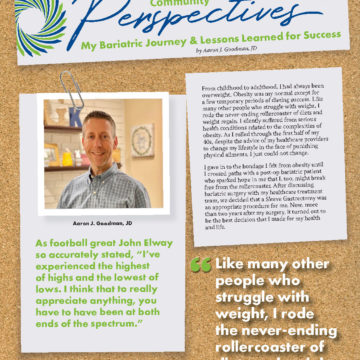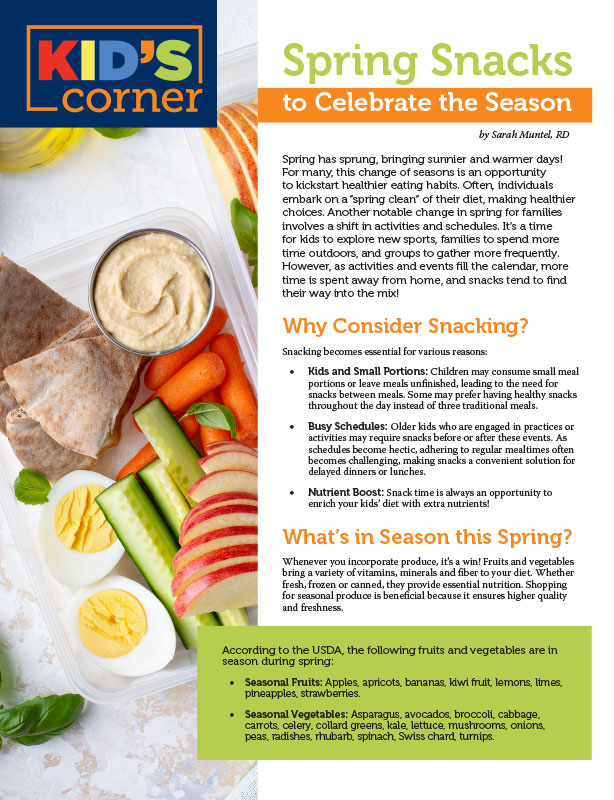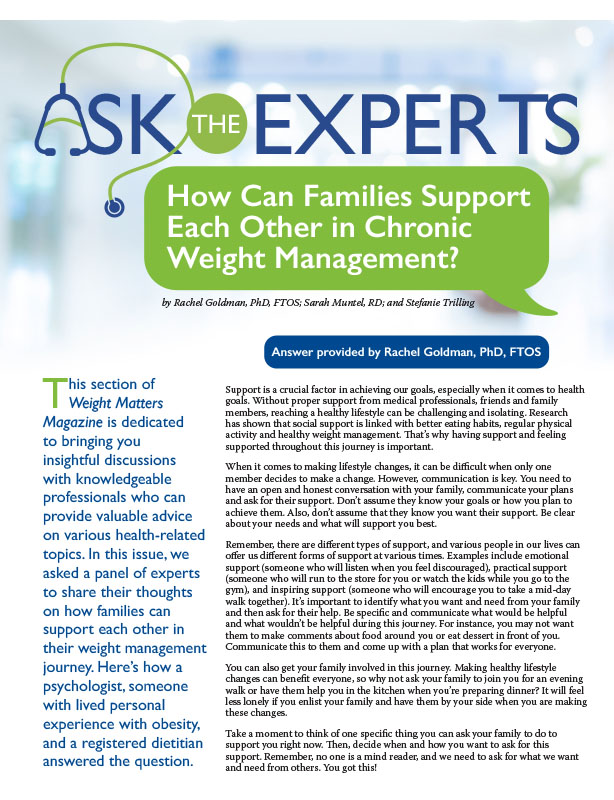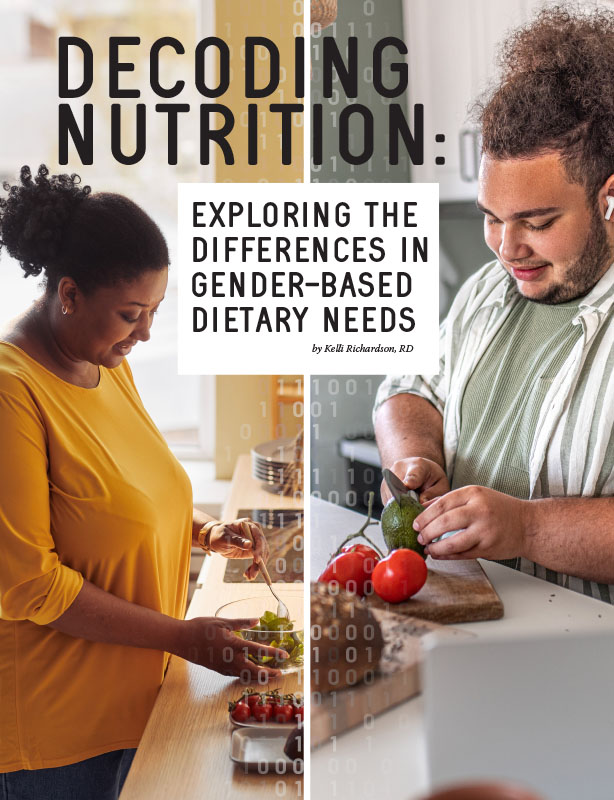All or Nothing Nutrition: Why Giving up Some Foods Limits the Potential for Healthy Eating

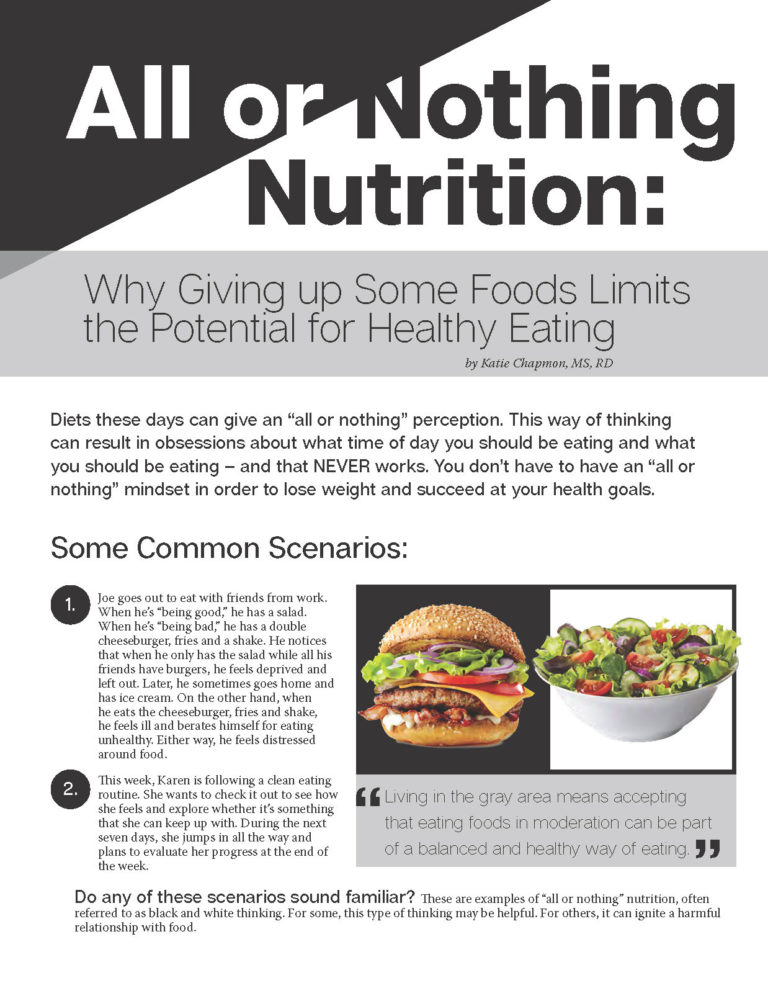
by Katie Chapmon, MS, RD
Diets these days can give an “all or nothing” perception. This way of thinking can result in obsessions about what time of day you should be eating and what you should be eating – and that NEVER works. You don’t have to have an “all or nothing” mindset in order to lose weight and succeed at your health goals.
Some Common Scenarios:
Joe goes out to eat with friends from work. When he’s “being good,” he has a salad. When he’s “being bad,” he has a double cheeseburger, fries and a shake. He notices that when he only has the salad while all his friends have burgers, he feels deprived and left out. Later, he sometimes goes home and has ice cream. On the other hand, when he eats the cheeseburger, fries and shake, he feels ill and berates himself for eating unhealthy. Either way, he feels distressed around food.
This week, Karen is following a clean eating routine. She wants to check it out to see how she feels and explore whether it’s something that she can keep up with. During the next seven days, she jumps in all the way and plans to evaluate her progress at the end of the week.
Do any of these scenarios sound familiar? These are examples of “all or nothing” nutrition, often referred to as black and white thinking. For some, this type of thinking may be helpful. For others, it can ignite a harmful relationship with food.
How All or Nothing Nutrition Can Go Wrong
Where all or nothing nutrition can go wrong is when anything less than “perfect” is perceived as a failure. All or nothing nutrition is commonly seen in people with eating disorders such as bulimia nervosa, binge eating disorder and anorexia nervosa.
This kind of rigid dieting defines food and eating behaviors as either good or bad. Thinking of eating in this way can then extend to defining one’s character in those same terms. Food can be viewed as scary and challenging, causing irrational thoughts. When all or nothing nutrition goes wrong, it can leave you feeling stuck, unhealthy and out of balance. You might even be constantly yo-yo dieting from one extreme to another.
Learning to change these thoughts requires you to start living in shades of gray. Living in the gray area means accepting that eating foods in moderation can be part of a balanced and healthy way of eating. In other words, this way of eating is flexible enough to be sustainable and embrace ambiguity at the same time.
How to Portion Your Meals
I like to call nutrition an art and a science. Portioning meals to include varied food groups allows you to get all of your necessary nutrients. Nutrition components that we include in our body are always changing. As you age and experience activity and environmental changes, it is important to stay in tune with your body and adjust your nutrition along the way.
A rough guide for balancing each meal is to be vegetable-forward. Half of your plate, or more, should be filled with vegetables which offer fiber and plenty of micronutrients. Make the most of your proteins and carbohydrates by choosing quality foods that are fueling. Proteins such as lean meat, poultry, fish, eggs or tofu should take up a little more than a quarter of your plate. Complex carbohydrates include both starchy vegetables and complex grains:
- Spaghetti squash
- Butternut squash
- Sweet potatoes
- Brown rice
- Quinoa
Ideally, carbohydrates should consist of a little less than a quarter of your plate. Add in about a half tablespoon of a healthy fat (avocados, nuts, etc.) and then you will have a balanced meal. From there, you can make adjustments to your meals based upon how often you eat, how hungry or full you are and how much physical activity you get.
How to Lean Yourself into an All or Nothing Diet
Some people want to try an all or nothing approach or they want to have some clear guidance with eating. If you’re considering leaning into an all or nothing approach, reflect on these self-evaluating questions that might help you figure out where to begin:
- Is it sustainable? If so, for how long?
- Have you tried something like this before? If so, how well did it go? What went well and what was difficult?
- Are there some foods that could be utilized or adjusted instead of eliminated?
- How different is this from what you’re currently doing? Will switching up your way of eating feel jarring?
- Could you practice some curiosity and take pauses to evaluate this approach?
It’s important to have a balanced nutritional baseline to start out with prior to approaching a strict meal plan. It’s typically difficult to adjust well to a strict meal plan because of the abrupt change in your diet. Once starting at a baseline, consider taking a week to practice a certain change. Evaluate what is sustainable, what is helpful (and what may not be) and then decide on your next steps. Leaning into an all or nothing approach takes a lot of evaluation and consideration.
Conclusion
Having a set plan for nutrition can guide you in your eating habits for a little while, but it also may feel too rigid and can even potentially lead to disordered eating. Perfectionism can throw off even the most logical mind, leading to lots of frustration and barriers with making progress. An all or nothing approach needs to be met with thoughtful consideration. Note that progress takes time and our efforts matter.
Healthy and Balanced Meal Ideas
Eggplant and Tomato Sauce
This simple and delicious sauce is vegetable and flavor forward. It is great served over a pasta and zoodle mix, but it’s also great as a side dish on its own.
Ingredients:
- 1 medium eggplant (cut in ½-inch cubes)
- 4 cloves garlic (smashed and chopped)
- 2 Tbsp. extra virgin olive oil
- 28 oz. canned plum tomatoes, including juice (coarsely chopped)
- Salt and fresh ground pepper
- Chopped basil or parsley (this can be used as garnish and/or for added flavor)
Instructions:
- Heat oil over medium-high heat in a large deep skillet. Once hot, sauté the garlic in oil.
- Add eggplant and cook about 3 minutes, until it begins to soften.
- Add coarsely chopped tomatoes to skillet, along with the juices.
- Season with salt, pepper and fresh chopped herbs. Enjoy!
Bountiful Bowl with Chicken, Mushrooms and Avocado
I love the color in this bowl and the burst of flavor that comes with it. This basic recipe can be modified to accommodate different nutritional focuses.
Ingredients:
- 1 lb. chicken breast, cut into cubes
- ¼ cup coconut aminos (a gluten-free alternative to soy sauce) or soy sauce
- Salt and pepper to taste
- 1 English cucumber, peeled, de-seeded and sliced into matchsticks
- 1 tsp. Yuzu hot sauce (or a combo of white vinegar, sesame oil and a hot sauce)
- 4 Tbsp. mayonnaise
- 3 Tbsp. Sriracha, adjusted to desired level of heat
- 3 Tbsp. avocado or coconut oil, divided
- 1 lb. riced cauliflower or 3 cups rice (or you can use a combination of both)
- 10 oz. shiitake mushrooms, sliced
- 1 tsp. ground ginger
- 1 large avocado, sliced
- 1 Tbsp. sesame seeds
Instructions:
- Prep the chicken: Place chicken in a plastic bag with coconut aminos or soy sauce, salt and pepper. Mix until chicken is coated and marinate in the refrigerator for 30 minutes or up to 2 hours.
- Prep the cucumber slaw: Toss the cucumber matchsticks with Yuzu hot sauce. Set aside, keeping cool.
- Prep the Sriracha mayonnaise: Mix mayonnaise and Sriracha until completely combined.
- Heat 1 tablespoon oil in a skillet. Add chicken, then cook until browned and cooked through (about 10 minutes). Use tongs or a spatula to ensure the pieces are cooked on all sides. Set aside.
- Meanwhile, heat 1 tablespoon oil in a separate skillet. Add cauliflower rice/regular rice and sauté until softened (about 10 minutes). Halfway through, add salt and pepper. Set aside.
- In the same skillet as the chicken, heat 1 tablespoon oil and add mushrooms. Cook until tender (about 10 minutes). Halfway through, add ground ginger, salt and pepper.
- Place chicken, mushrooms, cucumber slaw and sliced avocado over cauliflower rice. Drizzle Sriracha mayonnaise and sprinkle sesame seeds on top.
About the Author:
Katie Chapmon, MS, RD, is a Los Angeles-based Registered Dietitian specializing in the field of metabolic surgery and weight management since 2008. She currently works with individuals in-person and virtually all across the country.
by Sarah Muntel, RD Spring 2024 Spring has sprung, bringing sunnier and warmer days! For many, this…
Read Articleby Rachel Goldman, PhD, FTOS; Sarah Muntel, RD; and Stefanie Trilling Winter 2024 This section of Weight…
Read Articleby Kelli Richardson, RD You’ve probably heard the generic advice before: Eat your fruits and veggies. Limit…
Read Article





